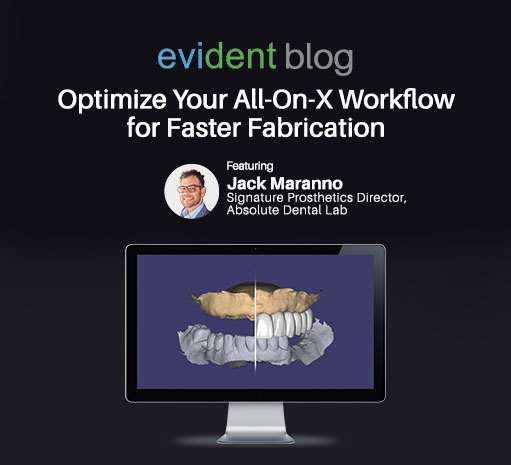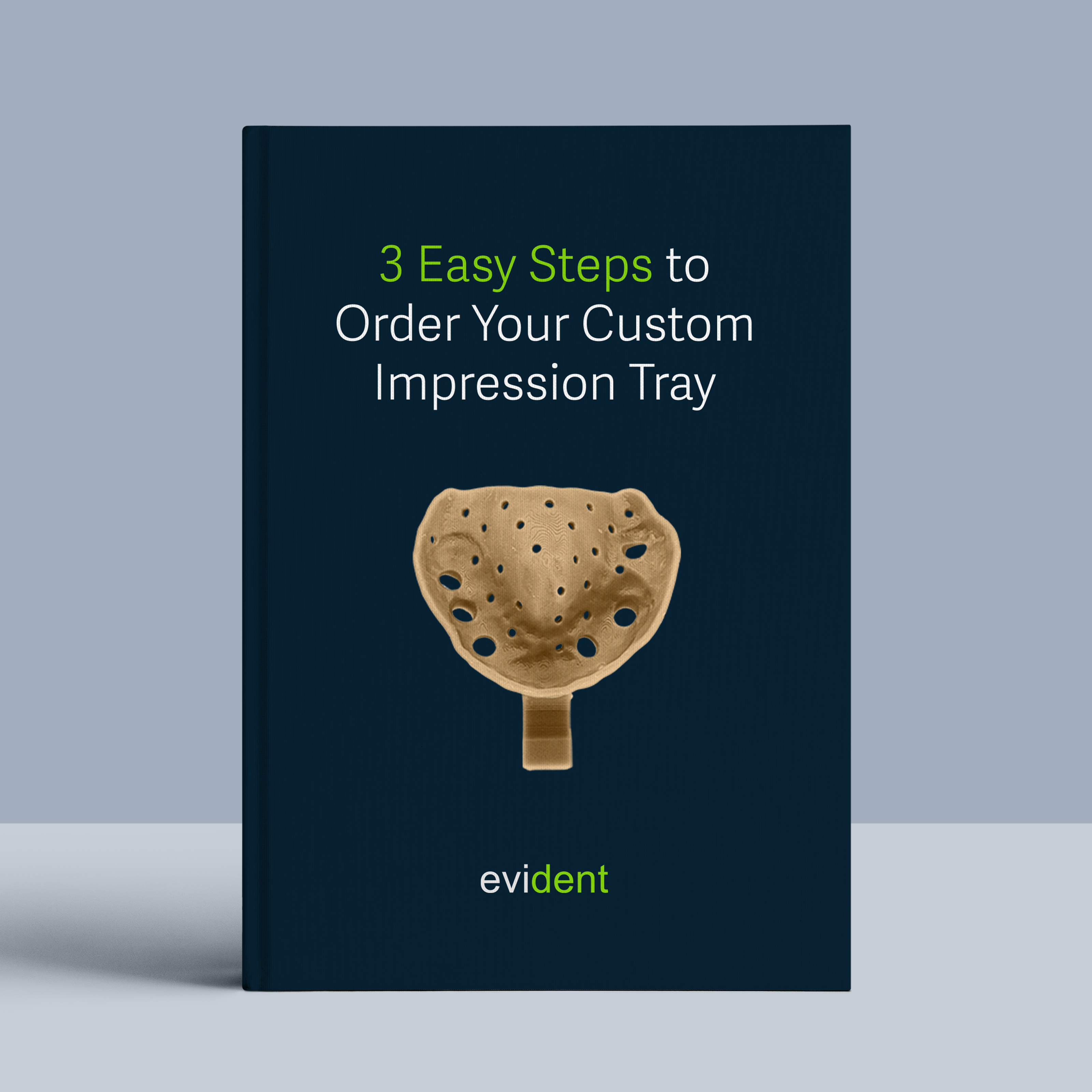

A lot of dental labs can produce All-on-X restorations within a month; two weeks of getting the prototype right and another two weeks of fabricating the case. That’s complete with staining and glazing.
However, there are a lot of commonplace issues that can significantly lengthen the time it takes to get to the final case. Jack Marrano, the 2023 American College of Prosthodontists Technician of the Year awardee, goes in-depth on how dental labs (and clinicians too) can optimize the All-on-X workflow.
Require Adequate Information
Jack discussed in a webinar interview how crucial it is to get adequate information from the dental office. Retrieving the right information prevents unnecessary back-and-forth and, as Jack puts it, labs won’t be redesigning a case a “bazzillion” times due to that inadequate information.
In the age of digital dentistry, scan and model files allow dental labs to accurately create a dental prosthesis through 3D printing or milling. But in addition to the scans and/or models, there is some more information labs should require before creating the virtual patient:
Photos of the Patient’s Mouth
Jack advises dental labs to require photos of the patient’s mouth. Specifically, a full-face, full-smile photo taken at head level.
This aims to get enough information on the patient’s anatomy, allowing for better design adjustments. Whereas with just the oral scan, the technician doesn’t have data on where the face is.
A full-face photo of the patient’s smile will save significant time from redesigning the prototype over and over just because the facial anatomy data isn’t there. Errors and headaches are minimized, resulting in a quicker prototyping and fabrication process.
It also saves time for the dentist since they’re not bringing the patient in again and again for try-ins.
3D dental software like 3Shape utilizes photogrammetry to convert 2D images into 3D renders. Jack imports these head-level photos into 3Shape to create an accurate 3D render of the patient’s jaw. From there, he designs the prototype directly in the mouth render.
Other Scans Required
The photogrammetry data from the photos is stacked with these other scans to create the most accurate virtual patient:
- Scan of the conversion
- Scan of the opposing
- Scan of the bite
- Scan of the scan bodies
- Scan of the abutment heads
Once the virtual patient is complete, the All-on-X case may be designed, fabricated, and shipped.
Verification
Sometimes, the final All-on-X case gets fabricated, but once it’s attached to the patient, something’s off.
Dentists’ patients would be wearing these fixed cases for the rest of their lives. It’s therefore critical that labs verify the prototype try-in. Also, getting it done right the first time minimizes material wastage and saves time. But for verification, labs need the cooperation of their dentists.
Here are some ways to ensure the prototype model is verified:
- Recommend your dentist to use verification jigs. A try-in prototype won’t serve a verification purpose. Errors in fit are more evident when verification jigs are used.
- During try-ins, ensure your dentist has taken crucial information and details (e.g., gingival architecture, overbite, etc.). This will allow you to make the necessary edits before moving to final.
Once a prototype try-in has been assessed, it’s either finalized or edited.
If it’s finalized, then the dental lab can fabricate the final All-on-X case. If a prototype needs to be edited, the clinician (or the lab, depending on who made the prototype) would need to create an altered prototype, then have the patient come in for a try-in. This process repeats until the prototype is finalized and verified.
Jack strongly disagrees with placing a titanium bar underneath an unverified All-on-X case. This will not remedy the fit. If anything, it will break and/or loosen the screws and cause additional complications with the case.
All-in-all, requiring detailed information and verifying during try-ins make a well-optimized All-on-X fabrication process.
But to really shift things into full gear, you may want to go fully digital for your All-on-X process.
Adopting a Fully-Digital Workflow
Minimizing the need for physical impressions and models will give your dental lab more streamlined operations. Here are some ways to adopt a fully digital workflow for your All-on-X fabrication process.
Eliminating the Ti-Base
A Ti-base (titanium base) can disrupt a digital All-on-X workflow because it requires a physical impression to be taken first. Jack elaborates that it’s nearly impossible to properly freehand cement a ti-base onto an implant without a physical impression first.
Eliminating the need for a ti-base removes (or minimizes) the need to create physical impressions. This allows dental labs to achieve a fully digital workflow, saving labs a lot of time.
Some ways of eliminating the Ti-Base include:
- Create a custom-made ti-bar with a two-degree taper. A ti-bar can be fabricated with the information from intraoral scans. Once a perfect-fitting ti-bar is made, the dental lab can design the zirconia All-on-X case on top of it.
- Apart from a ti-bar, labs may use direct-to-multi-unit abutment (DTMUA) screw systems (e.g., Rosen screw, Levee screw). These screw systems eliminate the need for a ti-base. In addition, they make connecting the implant to the abutment much simpler and reduce the number of components needed for the restoration.
Jack states that the ti-base is one of the biggest hindrances to a digital All-on-X workflow. So, once you get that out of the way, you’re well on the path to fully digital operations.
Use the Best Intraoral Scanner
Labs may supply intraoral scanners and rent them out to clinicians. This will be mutually beneficial to both the lab and the clinic. If labs digitize their clients’ chairside workflow, they streamline the overall All-on-X design and fabrication process.
The best intraoral scanners Jack recommends are TRIOS by 3Shape and Primescan by Dentsply Sirona.
Fabrication Automations
With the right systems, labs can leave their 3D printing machines and mills running 24/7, even over the weekend when everyone’s at home.
All-on-X cases are complex restorations, requiring several hours to a full day to produce, sometimes more. So, having machines run 24/7 would be an efficient way of fabricating All-on-X cases, especially if you have a lot of orders.
Outsource Partners
Jack mentions that 80% of dental technicians are over the age of 45. He proceeds to say that it’s a huge labor problem and that labs will have difficulty finding more techs to increase capacity.
He then advises dental labs to outsource partners to do more work. This will effectively increase a lab’s capacity. It will also allow for a smoother workflow since a significant portion of the work will be offloaded to the outsourced partners.
But make sure to choose the right partners — ones you trust to deliver work on time. At Evident, we can design your All-on-X cases for you. We are a fully digital dentistry company that helps labs with any digital design gaps they may have. Send us your scans with notes, and we’ll create that final All-on-X model that your dentists will be happy with.
We also have learning resources you may use to innovate your lab’s current processes. You can check them out here.
Simplifying the All-on-X Workflow
Jack has relentlessly emphasized the importance of sticking to the rules when creating All-on-X. No step can be skipped or skimmed over; otherwise, something goes wrong, like the zirconia breaking or the screws loosening. These issues and errors delay the fabrication process of the final restoration. It becomes all the more problematic for dental labs with large clientele.
The “ultimate” All-on-X workflow isn’t some quantum science complexity that takes years to develop. It’s simply being more stringent with information gathering and verification. Once that’s done, dental labs can optimize their operations further by adopting a fully digital workflow.









